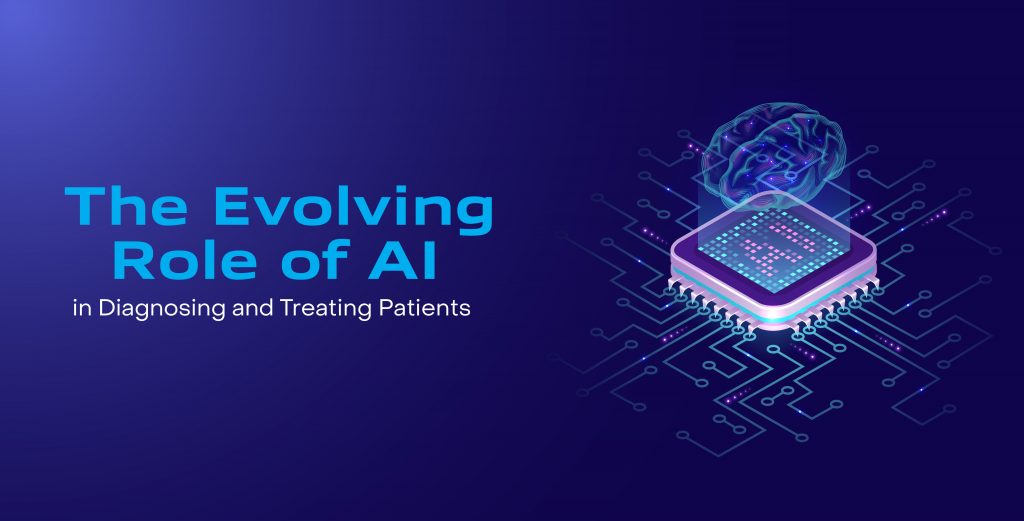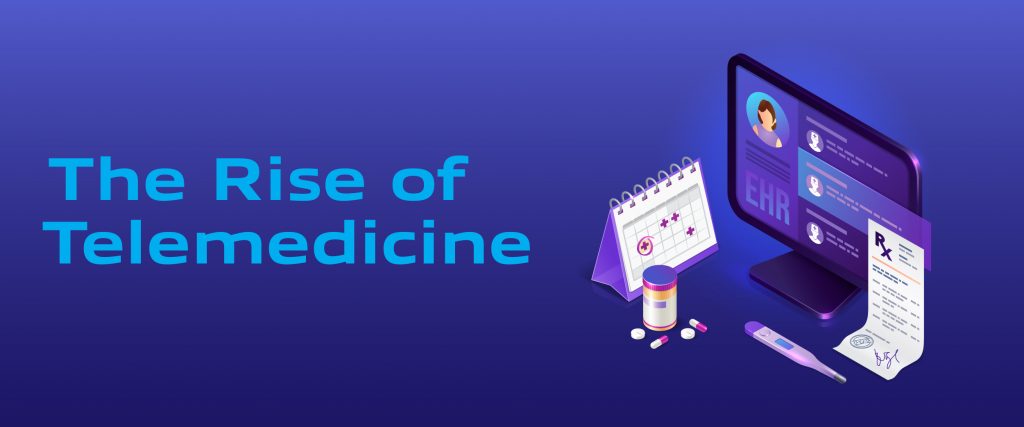
Introduction
Artificial intelligence (AI) has become a driving force behind innovation across numerous industries, with healthcare standing out as a prime example. The integration and role of AI in Diagnosing and Treating, telemedicine along with all Healthcare systems, has great potential for improving the accuracy of diagnoses, fine-tuning treatment plans, and ultimately making patient care better than ever.
In this blog, we explore AI in healthcare and how it can lend itself to multifaceted benefits for the healthcare sector with a special focus on the evolving role of AI in diagnosing and treating patients.
Our exploration covers established AI applications, architectural models, and the potential advantages and obstacles faced in embracing AI for healthtech transformation.
A Paradigm Shift, Post-pandemic: The Rise of Telemedicine

Telemedicine saved lives during the Covid-19 pandemic. It became an essential tool in delivering healthcare. I talked about how it set the stage for a paradigm shift in healthcare on Entrepreneur.
With the help of video consultations, patients were able to access medical care from the comfort of their homes – breaking down physical barriers in healthcare access.
Transporting elderly folks to their doctors appointments is becoming a big business, so much so that new business models have emerged from this. Lyft for Healthcare and Uber Health have partnered up with hospitals to make sure patients can get from their homes to appointments and back safely. And you know what’s even better? Nowadays, some appointments don’t require the patient to physically be at the hospital or clinic. Therefore; as a pre-consideration to booking appointments, it’s important to consider if a patient needs to travel or not. This speaks strongly on how a lot has changed with respect to the impact of AI on physician-patient relationships.
The integration of AI into telemedicine is taking virtual care a notch higher by offering greater accuracy and efficiency in diagnosis and treatment. For instance, a ChatGPT-style AI assistant can double up as an appointment coordinator and help with steps like clarifying questions, scheduling the correct specialist, and in fact skipping the step of talking to a GP first.
Startups such as GYANT are doing something similar with a “virtual front door”. Their chatbot asks questions in a conversational style, all the while triaging you to find the correct specialty or doctor for your needs.
Examples of telemedicine platforms that utilize this flat-rate approach include Teladoc Health, Doctor on Demand, SteadyMD, PlushCare, and HealthTap. These platforms enable patients to access a range of medical services, from primary care to specialist consultations, without the constraints of HMO insurance plans. By offering a more flexible, direct-payment structure, these telemedicine providers can potentially reduce healthcare costs, enhance convenience for patients, and extend access to quality care for individuals who may have limited coverage or face geographical barriers to accessing healthcare providers.
Beyond Images: AI’s Diagnostic Potential
AI’s potential to analyze medical images (X-rays, CT scans, etc.) has been explored for over a decade, but the impact of AI in Images and scans hasn’t had a major breakthrough in several years. Researchers and companies have been captivated by this use case, both Nuance Communications (acquired by Microsoft) as well the now-defunct IBM Watson Health have spent billions exploring AI’s diagnostic capabilities in medical imaging.
IBM Watson Health (now defunct) used a data-driven approach, leveraging a massive dataset to train a system for detecting anomalies in medical images like X-rays. This system relied on supervised learning, a type of machine learning where the model learns from labeled data. In this case, the model was trained on a large number of X-ray images with known anomalies, learning to recognize patterns and features associated with these anomalies. Once trained, the system could analyze new, previously unseen X-ray images and attempt to identify potential issues.
The huge leap that GPT-4 has taken is largely due to its architecture (which we don’t exactly know since OpenAI has not shared it) – but we know it is built using layers of Transformers as explained in the seminal paper Attention is All You Need. GPT also uses an advanced natural language processing model that uses Transformers to understand and generate human-like text. It excels at tasks like text generation, question-answering, and summarization.
Now the possibilities are far reaching to use this new technology to augment multiple facets of the healthcare system including the role of AI in diagnosing!
How Personalization Is A Pivotal Point In Healthcare AI
AI can also help develop personalized treatment plans for patients. By analyzing vast amounts of data, AI can identify the most effective treatment options based on a patient’s specific genetic makeup, medical history, and lifestyle factors. Used thoughtfully, this level of customization can lead to better patient outcomes and more efficient use of healthcare resources, but “efficiency” is often measured in ROI., so this will likely be utilized by insurance companies making it a win-win situation. Role of AI in Diagnosing and Treating Patients is growing with each passing day.
The Promise of AI In Remote Patient Monitoring and Predictive Analytics
The integration of AI with remote monitoring devices allows healthcare providers to track patients’ vital signs and other health metrics in real-time. AI algorithms can analyze this data to predict potential health issues, allowing for early intervention and prevention of complications.
AliveCor is one company that is using RPM for conditions like Atrial Fibrillation, and they have their own algorithm that will judge the rhythm. This proactive approach to healthcare can significantly improve patient outcomes and reduce hospital readmissions.
How are Ethical Implications Playing a Part With AI in the mix?
The ethical implications of relying on AI for patient care have to be discussed even if the benefits of AI in telemedicine are quite obvious. Data privacy and security are significant concerns, as the technology relies on the collection and analysis of sensitive patient information. Additionally, addressing biases in AI algorithms and ensuring equitable access to AI-powered healthcare services are essential to prevent disparities in care.
AI in Healthcare: What’s The Future Like?
AI has the potential to revolutionize telemedicine and healthcare delivery by improving diagnostic accuracy, personalizing treatment plans, and enhancing remote patient monitoring. Especially looking at how GPT-4 has a revolutionary architecture compared to the image processing supervised learning models of the past in health.
However, it is crucial to address the ethical considerations and challenges associated with AI adoption to ensure that its benefits are realized without compromising patient privacy or exacerbating healthcare disparities. As technology continues to evolve, it is essential for healthcare providers, policymakers, and patients to work together to harness the power of AI for the betterment of global health.


